Apple – one of the few companies that made history, more than once even; including the first company to reach a $1,000,000,000,000, or more conveniently, $1 trillion market- capitalization. Apple Inc., which was initially Apple Computer, Inc. until ’07 when they decided to drop ‘computer’ in a rather strategic move, is among the world’s largest manufacturer of PCs, software & peripherals.
The brainchild of Steve Jobs & Stephen G. Wozniak has been a major cause of the advancement in the world of technology back in 1977 when it was incorporated as well in the early 21st century. Consistently ranked as the largest company in market caps as well as brand-value, the Apple legacy has already spanned across two generations and is not ready to take a knee to any of its competitors, in the recent future.
The history of Apple Inc.
Apple, the rich company it is, has an ever-richer history. From its first product, Apple-I, a supremely powerful motherboard, without any other peripherals, to its latest iWatch that can aid in saving a man’s life from a heart-attack, Apple has come a long way. What started as a start-up in the Jobs’ family garage, by two friends because the then Hewlett-Packard had no intention of building the world’s first microcomputer, has higher revenues that some country’s GDPs.
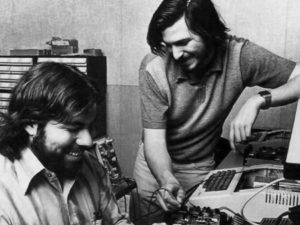
Apple-I & Apple-II were huge successes both in terms of hardware & software, and played a key role in the company’s early financing; but Apple has had its fair share of failed products too, like the Apple III & the Apple Lisa. The 1984 Macintosh was marked by several firsts for the company; Apple saw its first competitor in IBM. Apple entered into its first internal turmoil when the board deemed it fit to dismiss Steve Jobs as the Apple CEO in favor of John Sculley. Between that and 1997, Apple’s growth story hit a wall, and to remedy that problem Mr. Jobs was invited back to the helm, but only after Apple acquired NeXT Inc., whose then CEO was the original founder of Apple.

The world had changed in the time that Jobs was gone. The vision which he had when laying the foundations of Apple, which had been termed as to be ahead of its time, was, in 1997, finally achievable. The hardware world had finally caught up to its digital vision. In 1998, the iMac was launched, which did miracles for the Apple brand – the iMac became “most aesthetically pleasing machine on the market” and Apple’s sales surged. Nobody knew who or what Apple was, but everyone wanted to own an iMac. Additionally, that very event kicked off the start of what is today Apple’s most successful venture, the iEcosystem.
The Unique Apple Proposition
Since its inception, what Apple had to offer is a different USP, when compared to every other player in the market – the promise of unparalleled innovation. Each one of Apple’s products is design as-well-as quality-driven, and that’s how Apple thinks differently. Every Apple product has a unique experience in using it, and this how Apple has built its brand – not through premium-pricing or more-than-generous margins, but through creating an aura of memorable experience around it.
The vision statement that Apple as a brand promises, “Man is the creator of change in this world. As such he should be above systems & structures, and not subordinate to them”, has been realized over the years, as Apple so often lives up to its slogan – Think Different. While other brands have resorted to every trick in the book like M&A and competitive pricing, Apple managed to build a relationship with its customers; Apple moved beyond being a brand, and increasingly became a friendly name, with its own community of consumers, strengthened using heartfelt connections and robust service.
In this age of technology and increasing concerns about privacy, Apple has made one thing crystal clear, it values its consumer’s privacy. Through a swarm of advertisements specifically emphasizing and promoting its stand on privacy and protection on user data in India as well as in several other competitors, Apple has been able to set itself apart from every other competitor in this market sector. Apple’s non-negotiable on security and its impeccable record against digital attacks have positively contributed to Apple’s dominance in the public eye.
Apple, through its policy of innate attention to detail complemented by personnel expertise, and their unsaid-but-strictly-adhered-to dogma of keeping the bluntest human as its end-user, is able to deliver such a distinct-but-acute sense of flow & naturalness within their products and usage. And this is how Apple has built upon the widely-followed mantra – “if Apple does something, it’s the way it was always meant to be!”
The Apple product portfolio
In the years before the Jobs 2.0 era, Apple’s diverse product portfolio was causing the company to falter. The myriad of models catering to the same problems was outright confusing for the consumers. But then Steve Jobs introduced the now legendary 2 x 2 product matrix.
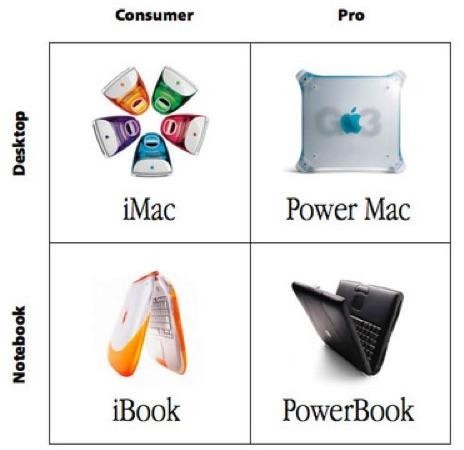
And since then, the company has tried its very best to stick to this matrix, and sometimes without much success. Still, the sheer strength and diversity of the Apple product line catering to the needs of users across the spectrum is mind-boggling and yet so elaborately perfect. A brief detail of this product portfolio gives an insight into Apple’s reach into the industry.
Starting with the Macintosh, Apple’s first hail-Mary, today comprises of the all-in-one, iMac, Mac Mini, MacBook Pro, the all-powerful Mac Pro & the MacBook Air. Comes with this is the wide variety of peripherals & accessories for its Macintosh line, like the Thunderbolt Display,Time Capsule, AirPort wireless, and the Magic Mouse, Trackpad & Keyboard.
Then the next big jewel in Apple’s crown is the iPhone & the ever-improving iPhone OS or as it is now called OS X. The list further goes on to include the iPad, iPod, Apple Watch, Apple TV, HomePod, and Apple’s indigenous fleet of software including the macOS, iOS, watchOS, and tvOS. In addition to this plethora of products, Apple has recently started invested in a prototype electric-vehicle line, as well.
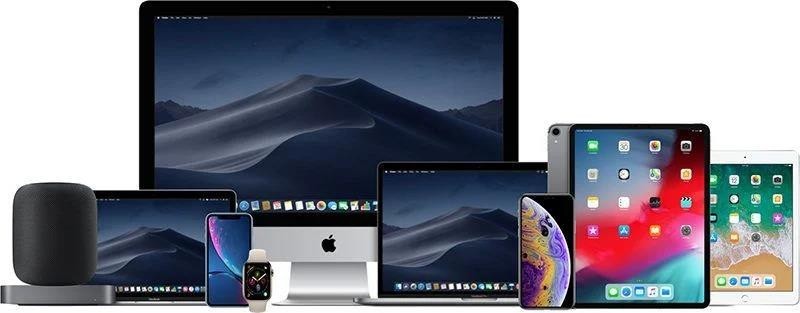
Currently, a vast majority of Apple’s products have been and are manufactured & assembled in China, but in the recent past, Apple has diversified its assembly line into India, Czech Republic, Thailand, Philippines, South Korea, Malaysia, and Singapore.
Every product in the Apple portfolio is closely monitored to meet expectations, and those who fail to do so are cut-off without a second glance. And this is how the brand has managed to keep its perfect garden of Eden and its perfect products from the webs of failing lines.
Also Read: Are You Sure It Isn’t Photoshopped? – The Journey Of Adobe Systems Inc.
Apple’s Strength – The brand and its loyalty
InterBrand, has consistently ranked Apple as the world’s best global brand consistently for more than the past five years. Apple’s brand tops the field in the areas of engagement, differentiation, and consistency. Apple’s intellectual brand value, calculated at $ 234.24B, shows the sheer strength that the name Apple holds. To put it in simpler terms, if one day all of Apple’s assets, shares, cash, production capabilities were to be no more, Apple would still be worth more than two hundred billion dollars, by virtue of being the Apple brand.
On its face, it seems like the iPhone is the biggest driver of the Apple brand, but its plethora of software services like the Apple Music, are the greatest drives of its brand loyalty. And this is how Apple thrives – it makes its consumer every bit of their iPhone purchase, be it through music or movies. And this generates untouchable consumer brand loyalty.
This brand loyalty, supplemented by the impeccable consumer experience Apple provides drives the sale of its other products, leading to the formation of the aforementioned iEcosystem. In the words of Paul Nelson, MD of BrandMatters, “That’s the financial genius that sits inside that brand – getting consumers to keep buying the hardware. Strong brands have clients who are simply disinterested in alternatives – and that’s where Apple’s strength lies. The fact that you just become a loyalist.”
Apple’s marketing strategy
Positive Reviews & Testimonials all around
A majority of Apple’s ad campaigns heavily rely on positive reviews and testimonial either from extensively-promoted free trails or long-time satisfied consumers, which work towards humanizing the brand, thereby strengthening the friendly-aura that surrounds the brand.
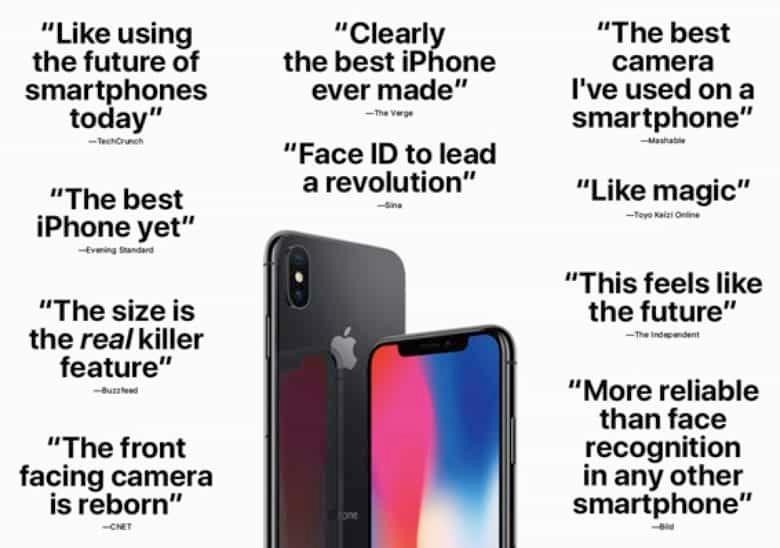
Simplicity & Minimalism
Another key-aspect that Apple focuses on its marketing efforts – the product will sell itself without relying on pomp and circumstance, ignoring the haughty product-launches. The apple logo and every simple ad, carries with itself a strong narrative of contented happiness that comes from a simplified lifestyle; the way of achieving that lifestyle – a result of owning an Apple product.
It’s about the Customer
Apple’s marketing efforts have always followed one core value – it’s about the consumer. A comprehensive and sustained analysis of Apple’s advertising campaigns by reputed newspaper and websites alike reveal a consistent finding – Apple’s campaigns are not focused on selling the product but how their product satisfies the needs of the consumer.
Apple has realized its mission of innovation by facilitating access to all their new products to the technology enthusiasts across the world, and ensuring that every question that any potential consumer might have for them is answered even before it is asked.
Also Read: The Superiority Of Amazon Logistics & Supply Chain
Apple’s Success Story with Indian Masses
Market Segmentation
Apple divided the Indian market into four key segments – creative professionals, business, education, and high-end consumers, before pursuing expansion into the country. This segmentation approach, followed by subsequent differentiated targeting is what allowed to capture a more-than-40% market share in the early years of its market entry. Apple’s strategy using retail-stores, following a more-or-less similar structure across the world, has been a great aid to Apple in penetrating the already competitor-dominated markets like India.
The Premium Experience
Apple’s worldwide perception of being a premium-brand, a brand that sets you ‘a class apart’, has been a key factor allowing it to capitalize on the Indian consumers’ receptiveness to that provides quality assurance, regardless of its premium-pricing. Apple’s strategy in India has been riddled with many obstacles – the world’s most competitive market is one of them. But Apple has survived through these hindrances and maintained its autonomy and identity, in contrast to its competitors entering into several partnerships for providing their products at subsidized rates. Apple’s heavy investment in R&D and reliance on launching new products, has very successfully instilled a need-to-have sentiment in all Apple consumers across the country as well as the world.
The Apple Comeback – Strategic Selling & Partnerships
Despite these initial grand success in the country, things turned dire for Apple in early-2018, with losing market share and declining sales. Apple was losing its prestigious mantel place in the Indian market. Grand announcements of new products were just not doing it for the Indian masses and Apple could no longer rely on dumping its ‘lesser’ models in India; but Apple recovered from this slump, like it always does – the last quarter of 2018 saw a massive surge of 41% in Apple’s growth and became the fastest growing brands in all of India.
Through strategically placed price-cuts and Indian market-specific launches, strong partnerships with local e-commerce players like Flipkart, and a lot of undeniable cashback and no-cost EMIs, Apple was able to capture a large share of the Indian market with consumers from varying socio-economic standings.
Reduced Costs & In-house Manufacturing
It wasn’t long before the Apple sales machine was well-oiled with Indian cash, that Apple managed to dramatically lower its production costs as it stepped up its manufacturing effects within the geographical borders of the country. Apple was able to take an important hint from the Trump-China trade-war and at the right time, ‘primed India for a steady climb up the value chain.’
Today Apple is competing with established competitors and Chinese players, in both hardware & software, across all market segments; and by the looks of it, Apple has larger investments planned for India, to be able to fully reap the low labor costs, almost half that of China, and the glorious fleet of capable engineers that the country has to offer.
Conclusion
Now, there is a good chance that you might be reading this article on your Apple device or maybe with one in your near vicinity. Some others might even be listening to their iPod during this read, or while being slightly distracted by the ping of their Apple Watch reminding them to wish their mother-in-law a happy birthday.
This fan frenzy, driven by its impeccable marketing strategies and the mere but crucial fact that all Apple products are aesthetically pleasing and a pleasure to use, has created the most powerful brand in the world. All of this complemented by the supreme quality of Apple products makes it much easier to stick with Apple, instead of switching over to a competing brand. And this recipe gives us the success story of Apple, a story that is most likely to continue and grow in the recent future.
To read more content like this, subscribe to our Newsletter.
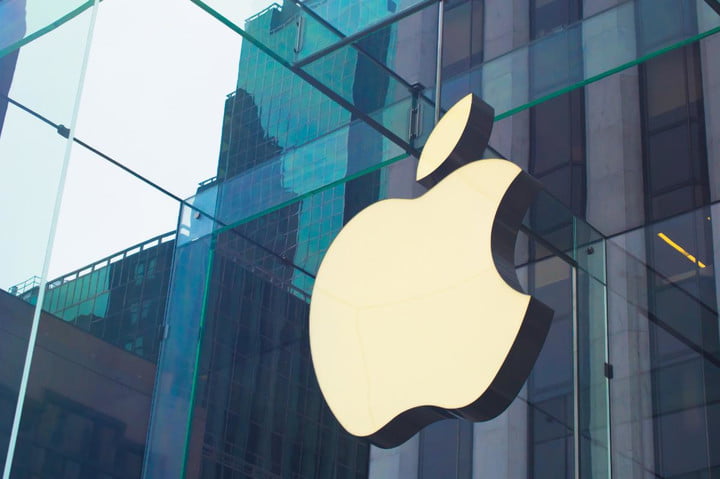

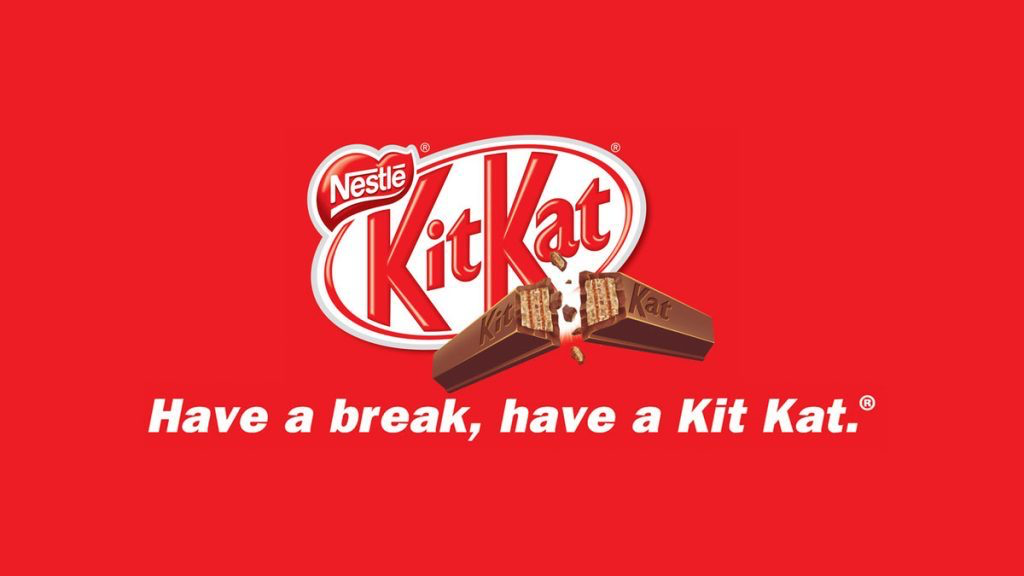

Good luck to your blog as I continue to follow regularly. Georgianna Gunner Rouvin
It is not my first time to go to see this website, i am visiting this website dailly and get good data from here everyday. Daphene Jeramie Lewes